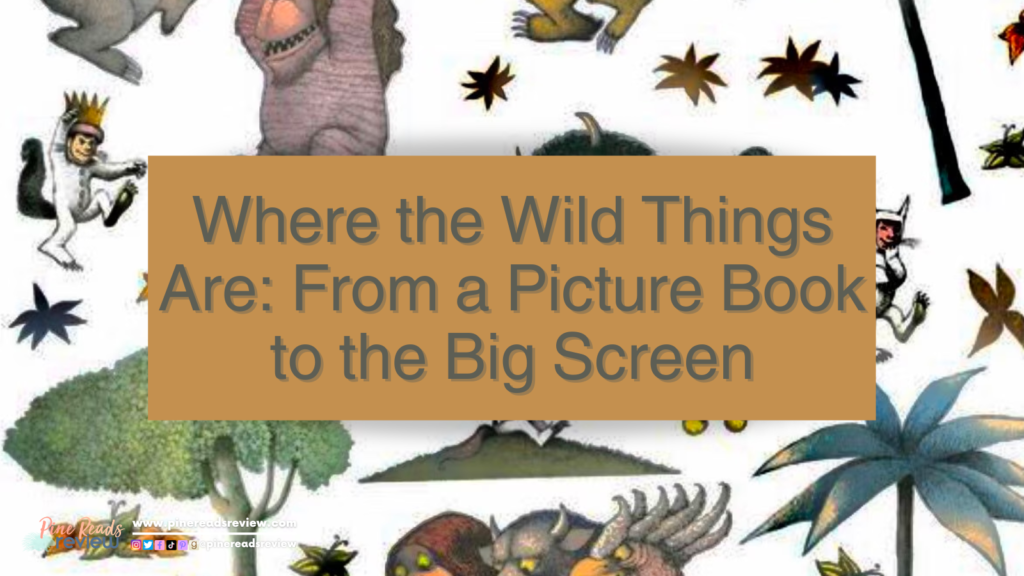
When I was little, I used to be full of excitement getting ready for bed. I’d rush through my nighttime routine and then curl up in bed, waiting for my mom to read me a bedtime story. Whenever I saw a cover with a small sailboat and a giant sleeping creature, I knew I was about to enter the world of Where the Wild Things Are. Maurice Sendak wrote a wondrous picture book exploring a child’s imagination, and it happens to be one of my favorite childhood bedtime stories. Entering a world full of energetic creatures and no rules is every kid’s dream, and when I found out that this world was coming to the big screen, I was thrilled. Exploring the two mediums, I will consider their relationship to one another and how the film strayed from Sendak’s book.
Rereading Where the Wild Things Are as a young adult was an entirely different experience from when I was little. When I was young, I was focused on the dreamlike world Max created in his bedroom, wishing that trees would grow in my own room. However, Max is a child dealing with a lot of emotions, particularly his anger, which didn’t stand out to me when I was younger. He’s upset about following rules, listening to his mother, and being treated like a child. The wild things meant so much to him because they gave him the freedom to be an adult. Nevertheless, he quickly realizes that being an adult and being in charge isn’t all he dreamt it to be, and he misses his home.
The film does have similarities in this sense. Max is still angry, grasping onto the idea of no rules and the desire to be grown up. The film differs from the book in its imagery of Max’s emotions; we’re able to see how he’s struggling in the film, making for a much more complex character. Max doesn’t feel like he fits in with those around him, making him indignant and lonely. We see this through a series of shots highlighting Max’s being alone and making his own fun—but this isn’t fulfilling for him. This ultimately leads Max to run away from home and sail off to where the wild things are (ha!). While the book does show Max as an irate child, the root of his anger isn’t explored. The film, however, has more room to develop Max’s character, allowing us to see his intense emotions about the world around him.
Something that immediately drew me to this book were the creatures. They have curious illustrations, unlike any that I’d seen before. In the book, the creatures remain unnamed, and we don’t know them individually. They give Max an opportunity for amusement and power, and the reader has fun alongside them all. The film, however, gives us in-depth characterizations of the creatures, naming them all and casting them as beings that have feelings and struggles just like us. Max takes the time to get to know them all individually, becoming closest to Carol and KW. He learns about their insecurities and how the creatures’ actions affect each other—something that he hadn’t considered with his mom or sister. These experiences give Max the ability to emphasize and build friendships with the creatures. The book gives us a surface-level peek into Max and the creatures, whereas the film inserts us into their lives—making us form attachments to the wild things. Max forms these attachments as well, feeling a great sadness when he leaves their island, though he knows it’s for the best.
What the book and film both rely on is the overarching message of “home is where the heart is.” Home is with people you love and care for deeply, where you can embrace emotion. I think this message is much clearer in the film, as it shows us Max’s family. In the book, we’re left to imagine his family for ourselves. Either way, Max yearns for home after having spent his time with the creatures. While he has fun with his new friends, he realizes that they can never replace where he came from. The film dives deeper into this idea than the book, giving Max the opportunity to learn about empathy. This makes him realize that he should’ve considered his family’s feelings alongside his own. Learning to understand the emotions of others and taking the time to acknowledge what they are going through becomes important to Max after living with the wild things.
Where the Wild Things Are makes for a captivating picture book and an equally captivating film. Personally, the book has a lot of meaning to me because of all the wonder it brought me when I was little. As a young adult, the film holds more meaning for me due to its emotional nature and the nostalgia it brings me. Many of the differences between the film and book are expected since there is much less room to explore the characters, their emotions, and their world in a picture book than there is in a full-length film. Nonetheless, children can make their own world beyond the book. One disclaimer: I would probably not recommend the film for young children, because the film does have scenes of the creatures that could be frightening. The story is heartwarming, but the creatures’ animalistic tendencies aren’t for all kids. On the other hand, I can recommend the book for readers of all ages. Whether you’re reading it for your kids or for your own nostalgia, Where the Wild Things Are is a story to adore.
Danielle Francesconi, Pine Reads Review Writer and Social Media Intern